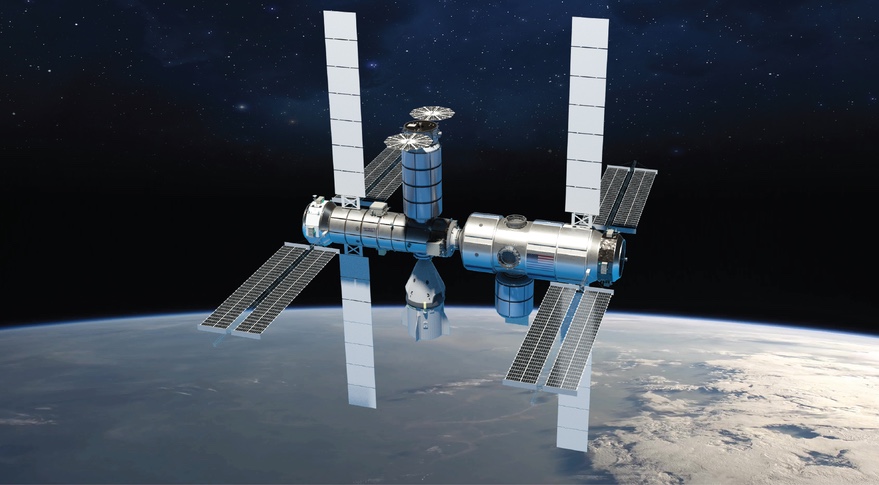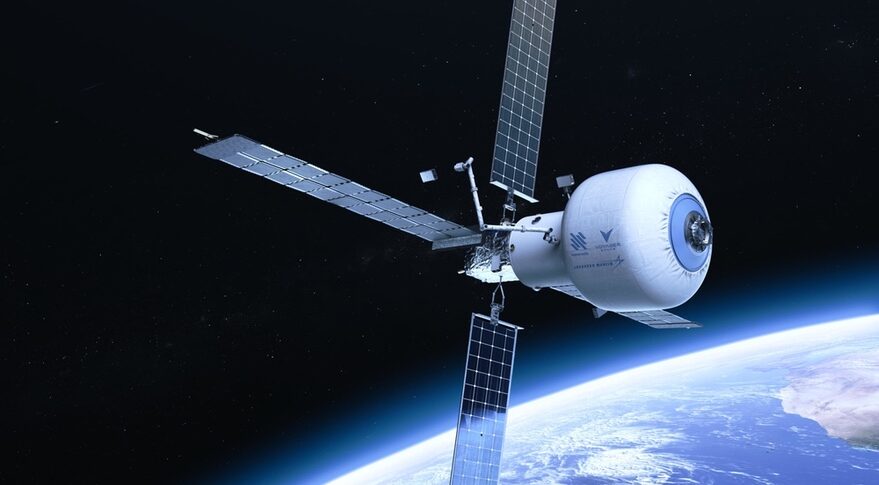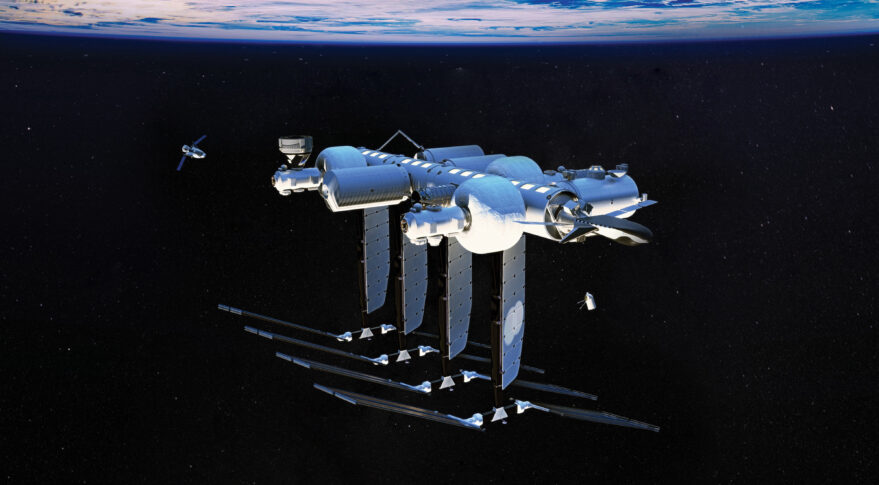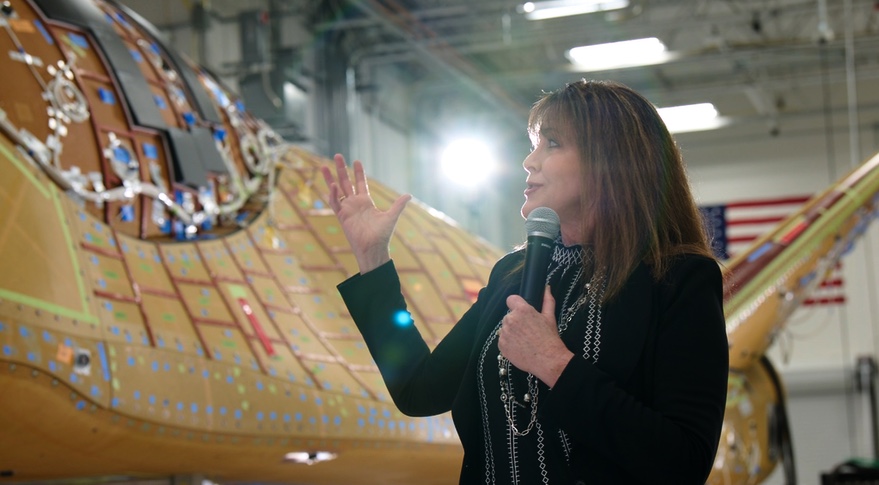ISS transition to commercial stations poses challenges for partnersby Jeff Foust — February 23, 2022 [SN]
 Northrop Grumman, one of three companies winning commercial space station development awards from NASA Dec. 2, proposes building a station leveraging work on its Cygnus cargo spacecraft and HALO module, among other projects. Credit: Northrop Grumman
Northrop Grumman, one of three companies winning commercial space station development awards from NASA Dec. 2, proposes building a station leveraging work on its Cygnus cargo spacecraft and HALO module, among other projects. Credit: Northrop GrummanWASHINGTON — NASA’s plans to shift from the International Space Station to commercial space stations may force one key partner to rethink how it cooperates in low Earth orbit.
Speaking at a panel on space diplomacy organized by George Washington University’s Space Policy Institute Feb. 23, Sylvie Espinasse, head of the European Space Agency’s Washington office, said the current arrangements between ISS partners to barter resources won’t work well on future commercial stations in low Earth orbit.
Source:
https://spacenews.com/iss-transition-to-commercial-stations-poses-challenges-for-partners/Additional funding unlikely to accelerate commercial space station projectsby Jeff Foust — March 25, 2022 [SN]
 Companies say that while additional funding will help with risk reduction, it may not accelerate schedules of their development much. Credit: Nanoracks
Companies say that while additional funding will help with risk reduction, it may not accelerate schedules of their development much. Credit: NanoracksWASHINGTON — Companies developing commercial space station concepts for NASA say they’re working as fast as they can and that additional funding would not speed up their work significantly amid concerns about the long-term viability of the International Space Station.
Source:
https://spacenews.com/additional-funding-unlikely-to-accelerate-commercial-space-station-projects/Orbital Reef passes design reviewby Jeff Foust — April 5, 2022 [SN]
 Blue Origin and Sierra Space announced Orbital Reef in October 2021 as part of a partnership with Boeing, Redwire Space and several other companies and organizations. The station will ultimately feature a series of laboratory and habitation modules.
Blue Origin and Sierra Space announced Orbital Reef in October 2021 as part of a partnership with Boeing, Redwire Space and several other companies and organizations. The station will ultimately feature a series of laboratory and habitation modules.COLORADO SPRINGS, Colo. — Orbital Reef, a commercial space station being developed by a consortium of companies, has completed an initial design review as part of a NASA award.
Blue Origin and Sierra Space, the lead partners in the project, announced April 5 that Orbital Reef completed a system requirements review. The review was one of the first milestones in a $130 million funded Space Act Agreement NASA awarded the companies as part of its Commercial Low Earth Orbit Destinations, or CLD, program.
https://spacenews.com/orbital-reef-passes-design-review/Sierra Space to start astronaut training programby Jeff Foust — June 14, 2022 [SN]
 Janet Kavandi, president of Sierra Space and a former NASA astronaut, will lead the company's new astronaut training center. Credit: Sierra Space
Janet Kavandi, president of Sierra Space and a former NASA astronaut, will lead the company's new astronaut training center. Credit: Sierra SpacePASADENA, Calif. — Sierra Space is creating an astronaut training program led by a company executive and former NASA astronaut as another step in developing a crewed version of its Dream Chaser vehicle and a commercial space station.
The company announced June 14 it was opening a commercial human spaceflight training center and astronaut training academy at its offices at the Kennedy Space Center. Janet Kavandi, a former NASA astronaut and president of Sierra Space, will lead the center.
https://spacenews.com/sierra-space-to-start-astronaut-training-program/NASA safety advisers warn ISS transition plans on “precarious trajectory”by Jeff Foust — July 22, 2022 [SN]
 The proposed Orbital Reef station can be expanded over time by adding more modules, but initially will be about one-third the size depicted here. Credit: Blue Origin
The proposed Orbital Reef station can be expanded over time by adding more modules, but initially will be about one-third the size depicted here. Credit: Blue OriginWASHINGTON — NASA’s safety advisers warn that the agency’s efforts to transition from the International Space Station to commercial space stations without a gap are on a “precarious trajectory.”
At a July 21 meeting of the Aerospace Safety Advisory Panel, members said they were concerned that commercial stations whose development is being supported by NASA were unlikely to be ready in time before the ISS is retired at the end of the decade, and that those efforts suffered from insufficient budgets.
https://spacenews.com/nasa-safety-advisers-warn-iss-transition-plans-on-precarious-trajectory/NASA open to extending ISS beyond 2030Jeff Foust November 3, 2023 Updated Nov. 6 with statement from Bowersox.
 The International Space Station as seen from a Crew Dragon spacecraft in 2021. Credit: NASA
The International Space Station as seen from a Crew Dragon spacecraft in 2021. Credit: NASAWASHINGTON — A NASA official opened the door to keeping the International Space Station in operation beyond 2030 if commercial space stations are not yet ready to take over by the end of the decade.
Speaking at the Beyond Earth Symposium here Nov. 2, Ken Bowersox, NASA associate administrator for space operations, said it was “not mandatory” to retire the ISS as currently planned at the end of the decade depending on the progress companies are making on commercial stations.
https://spacenews.com/nasa-open-to-extending-iss-beyond-2030/